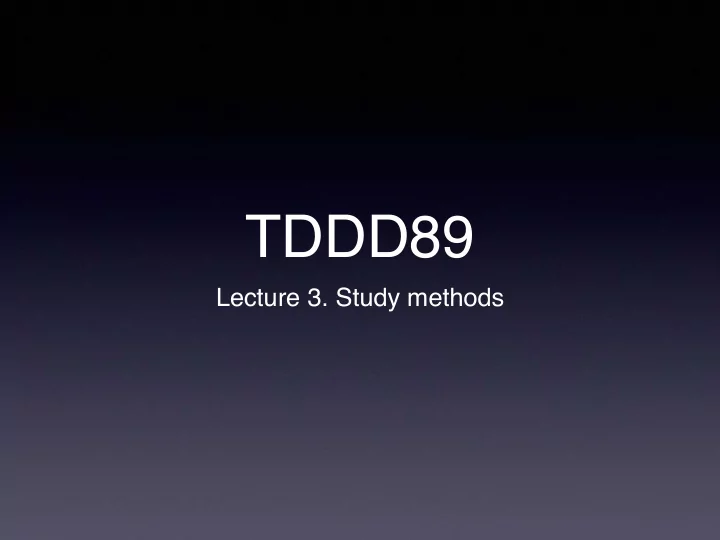

TDDD89 Lecture 3. Study methods
What is a scientific method? •Design, implement, test? •Acquire data, aggregate, visualise?
Method • Study design, data selection • What is achievable, what is necessary, what is best?
Different types of methods • Qualitative methods: establish concepts, describe a phenomenon, find a vocabulary, create a model • Quantitative methods: make statistical analyses, quantify correlations, ..
Human-Centered methods • Surveys • Interviews • Observations • Think-aloud sessions • Competitor analysis • Usability evaluation • ...
Method choice? • What do you want to find more about? • Identify the stakeholders (users, costumers, and purchaser) • Identify their needs
Interviews • Structured or unstructured? • Group interviews (focus groups) or individual interviews? • Telephone interviews
• Use open-ended questions, ex.: •Do you like your job? •What do you think about your job? • Active listning • Record the interview • Plan and schedule for that!
Interview analysis • Transcribe or not? • Categorize what has been said (encode)
Observations • Understand the context • Write down what you see, hear, and feel • Take pictures • Combine with interview • Ask users to use systems if availabe
Usability evaluation • System usability scale (SUS) • Post-Study System Usability Questionnaire (PSSUQ) • Heuristic evaluations • Eye tracking • First click Testing • …..
• System usability scale (SUS)
Usability performance measurement • Task success • Time (time/task) • Effectiveness (errors/task) • Efficiency (operations/task) • Learnability (performance change)
Software Engineering Acceptance Requirements Testing Architecture System Testing Integration Design Testing Implementation Unit Testing
Other types of theses Performance Problem Algorithm results Algorithm Algorithm Development Performance Company/Team Development Process results Development Process Process
Product Study s techniques Requirements Interviews Surveys Focus Groups Architecture Experiments Design Proofs Implementation
Proces Study s techniques Surveys Planning Interviews Development Focus Groups Testing Case Studies Integration Deployment Maintenance
Describing a method Don’t write a diary: • ”To implement a Flux controller, I first needed to learn about Flux” Write that which convinces someone you have done a good job • ”The Flux controller was evaluated using the Flux controller evaluation protocol [1]”
Engineering method vs scientific method Engineering Method questions Scientific aspect aspect Have you used Is it clear that the Can I trust your techniques & evaluation will work? methods intended provide the kind of for the task? answers we seek? Are all techniques and methods Can I build on your Can I replicate the employed work? study? described in sufficient detail?
Case Study • Investigates a phenomenon in a context, • with multiple sources of information, • where the boundary between context and phenomenon may be unclear • Uses predominantly qualitative methods to study a phenomenon
Quantitative studies • Uses statistical analyses of some empirical data • Randomization of subjects • Blocking (grouping) subjects based on confounding factors
Factors • That which may correlate with (and possibly cause) an effect • ”How does SCRUM affect product quality as measured by the number of bugs?” • ”How is code quality affected by the choice of programming language ?” • ”How understandable is a design document when creating procedural and OO design, based on good/bad requirements ?”
Analysis • There must be a null hypothesis which we can test our data against • One factor, two treatments: t-test, Mann-Whitney • One factor, several treatments: ANOVA • Two factors: ANOVA
Statistics • There are separate statistics courses, but.. • Separate correlation and causality • Unless >= 95% confidence, there is no correlation • Confidence only part of statistical power (confidence + effect size + sample size)
Discussion cause- effect construct Theory Cause Effect treatment-outcome Observatio construct Treatment Output n ”Do all arrows exist?”
Discussion, example Does agile development lead to higher quality code? cause- effect construct Agile Fewer dev defects treatment-outcome SCRUM/ construct Bugs No reported SCRUM
Examples • Evaluation • ... • Design • ... • Improvement • ...
Work in a context • Are the authors aware of how this work will affect others? • ”The commits with lowest code quality will be listed on the team review board” • ”More classification data will improve analysis of user behaviour”
Recommend
More recommend